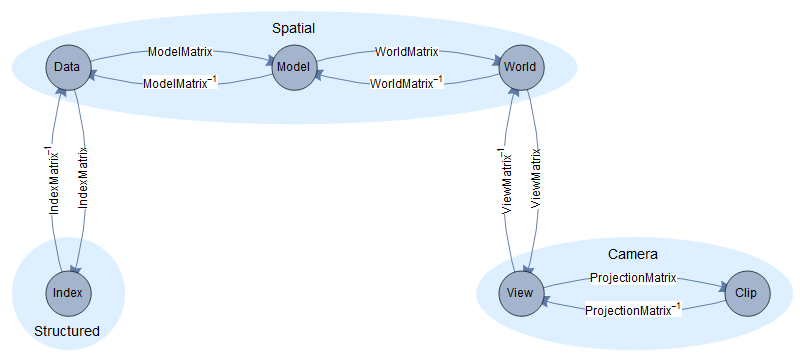 |
Inviwo 0.9.12-pre
Inviwo documentation
|
 |
Inviwo 0.9.12-pre
Inviwo documentation
|
A convenience class to generate transformation matrices between the different coordinate systems in use. More...
#include <inviwo/core/datastructures/spatialdata.h>
Public Member Functions | |
| virtual SpatialEntity * | clone () const =0 |
| virtual const Axis * | getAxis (size_t index) const =0 |
| glm::mat3 | getBasis () const |
| virtual const SpatialCoordinateTransformer & | getCoordinateTransformer () const |
| virtual const SpatialCameraCoordinateTransformer & | getCoordinateTransformer (const Camera &camera) const |
| glm::mat4 | getModelMatrix () const |
| glm::vec3 | getOffset () const |
| glm::mat4 | getWorldMatrix () const |
| SpatialEntity & | operator= (const SpatialEntity &that) |
| void | setBasis (const glm::mat3 &basis) |
| void | setModelMatrix (const glm::mat4 &modelMatrix) |
| void | setOffset (const glm::vec3 &offset) |
| void | setWorldMatrix (const glm::mat4 &worldMatrix) |
| SpatialEntity (const glm::mat4 &modelMatrix) | |
| SpatialEntity (const glm::mat4 &modelMatrix, const glm::mat4 &worldMatrix) | |
| SpatialEntity (const SpatialEntity &rhs) | |
Protected Attributes | |
| std::unique_ptr< SpatialCameraCoordinateTransformer > | cameraTransformer_ |
| glm::mat4 | modelMatrix_ |
| std::unique_ptr< SpatialCoordinateTransformer > | transformer_ |
| glm::mat4 | worldMatrix_ |
A convenience class to generate transformation matrices between the different coordinate systems in use.
Spatial meta data in Inviwo uses 4 different coordinate systems, they are defined as
A matrix is always stored in a 1 dim array, for example a 4x4 matrix would be: m = (1,2,3,4,5,6,7,8,9,10,11,12,13,14,15,16) in c/c++, that uses row major, that translates to a matrix like
m[0][0]=1 m[0][1]=2 m[0][2]=3 m[0][3]=4 m[1][0]=5 m[1][1]=6 m[1][2]=7 m[1][3]=8 m[2][0]=9 m[2][1]=10 m[2][2]=11 m[2][3]=12 m[3][0]=13 m[3][1]=14 m[3][2]=15 m[3][3]=16
here the first index represent the row and the second the column: m[row][column]. On the gpu, that uses column major, the same array would look like:
m[0][0]=1 m[1][0]=5 m[2][0]=9 m[3][0]=13 m[0][1]=2 m[1][1]=6 m[2][1]=10 m[3][1]=14 m[0][2]=3 m[1][2]=7 m[2][2]=11 m[3][2]=15 m[0][3]=4 m[1][3]=8 m[2][3]=12 m[3][3]=16
here the first index is the column and the second the row: m[column][row]
For example to create a translation matrix for on the gpu you want:
1 0 0 dx 0 1 0 dy 0 0 1 dz 0 0 0 1
That means that in c/c++ you would create a transposed matrix like:
1 0 0 0 0 1 0 0 0 0 1 0 dx dy dz 1
GLM also uses column major hence in glm you write m[column][row] hence you would enter the a translation like:
m[0][0]=1 m[1][0]=0 m[2][0]=0 m[3][0]=dx m[0][1]=0 m[1][1]=1 m[2][1]=0 m[3][1]=dy m[0][2]=0 m[1][2]=0 m[2][2]=1 m[3][2]=dz m[0][3]=0 m[1][3]=0 m[2][3]=0 m[3][3]=1
This means that they have the same representation as on the gpu.

|
pure virtual |
returns the axis information corresponding to index
index Implemented in inviwo::CompositeTransform, inviwo::Layer, inviwo::LightSource, inviwo::Mesh, inviwo::SpatialIdentity, inviwo::Volume, and inviwo::VolumeTetraMesh.